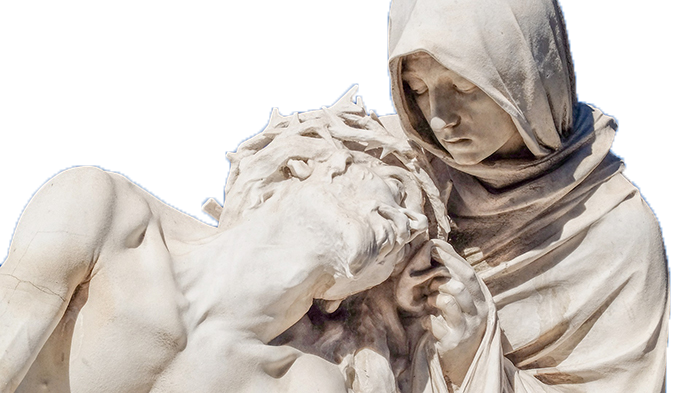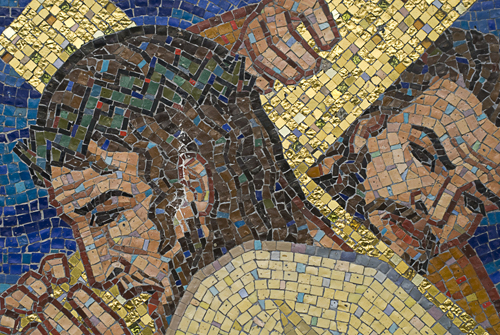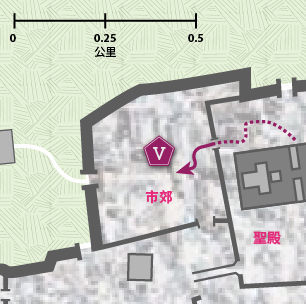[:zh]

瑪利亞的苦路
祢以慈愛派遣了祢的聖子

第五處 西滿幫耶穌背十字架

領:
主,基督,我們欽祟祢,讚美祢﹐ (單膝跪下)
眾:
因為祢藉著這十字聖架,救贖了普世。 (起立)
領:
祂的每一分痛都痛入我的心中,我但願整件事到了終結。
To purchase the entire text of Mary’s Way of the Cross, please visit www.twentythirdpublications.com/stofcrboforw.html.
NOTE: Quotations/Prayers from Richard Furey taken from Mary’s Way of the Cross, by Richard Furey, published by Twenty-Third Publications. Used with permission.
誦唱
眾:
目睹愛子橫遭極殃,慈容黯淡涕淚徬徨,孰能見此不同傷。
說明: 聖子高懸. Stabat Mater. At the cross her stations keeping,為一首封齋期聖樂﹐華人天主教會使用於封齋期彌撒及拜苦路。基督新教的聖公會路德宗等保守宗派 (翻譯為聖母哀傷或瑪利亞哀悼) 則使用於受難周的禮拜。歌詞內容以聖母瑪利亞的角度﹐去弔唁耶穌基督的死亡﹐教徒藉由誦唱並追隨聖母瑪利亞默想耶穌的受難。
聖地‧苦路‧冷知識
默想
耶穌步行時的身體狀況
耶穌被猛烈鞭打後,已虛弱得無法背負橫木到釘十字架的刑場,那裡距離比拉多總督府約六百米。
[翻譯自: On The Physical Death of Jesus Christ—Edwards et al, 1986]
十字架是橋樑
主耶穌,面對困難、痛苦,我們總想逃避。但苦路的第五處提醒我們,十字架正是把祢我連接起來的橋樑。我們都是西滿,每每在不情願的情況下才勉強背起十字架。讓我別忘記在十字架另一端的正是祢。求祢幫助我鼓起勇氣,稍為減輕祢的負擔。
[Rosa Tse, 2015]
鞭打苦刑的實況
罪犯會被脫光衣服﹐雙手綁在木柱上﹐由兩個士兵輪流鞭打或由一個士兵轉換位置來鞭打﹐打在背部﹑臀部或腿部﹐鞭打的力度由執行刑罰的士兵決定﹐目的在折磨罪犯﹐但不至令他崩潰或死亡﹐鞭笞後﹐士兵都會嘲弄罪犯。當行刑手用力重覆鞭打罪犯時﹐鐵球會做成嚴重的瘀傷﹐而皮條和尖骨會割破皮膚和皮下組織﹐持續的鞭打會撕破肌肉﹐做成一條條血肉模糊的傷痕﹐劇痛和失血會引致休克﹐失血多少決定死囚在十字架上可捱時間的長短。
耶穌被嚴刑鞭打﹐劇痛和失血令祂處於接近休克狀況﹐加上流血汗令祂的皮膚非常脆弱和敏感﹐祂所受的肉體和精神虐待﹑加上缺乏食物﹑食水和睡眠令祂的健康狀況大大被削弱﹐所以﹐就是在被釘十字架前﹐祂已處於嚴重的虛弱狀況﹑甚至到生命只懸於一線的地步。
[從醫學角度看耶穌的苦難 郭詠觀醫生, 2011]
Sharing the the Suffering of Christ
They were looking for someone to help carry the Cross.
Their eyes fell on Simon. They compelled him to take the weight upon his shoulders. We can imagine that Simon did not want to do this and objected. Carrying the cross together with a convict could be considered an act offensive to the dignity of a free man. Although unwilling, Simon took up the Cross to help Jesus.
In a Lenten hymn we hear the words: “Under the weight of the Cross Jesus welcomes the Cyrenean”. These words allow us to discern a total change of perspective: the divine Condemned One is someone who, in a certain sense, “makes a gift” of his Cross. Was it not he who said: “He who does not take up his cross and follow me is not worthy of me” (Mt 10:38)?
Simon receives a gift.
He has become “worthy” of it.
What the crowd might see as an offence to his dignity has, from the perspective of redemption, given him a new dignity.
In a unique way, the Son of God has made him a sharer in his work of salvation.
[St. John Paul II, Via Crucis, Totus Tuus, 2000]

玛利亚的苦路
祢以慈爱派遣了祢的圣子

第五处 西满帮耶稣背十字架

领:
主,基督,我们钦祟,赞美祢,(单膝跪下)
众:
因为祢借着这十字圣架,救赎了普世。(起立)
领:
祂的每一分痛都痛入我的心中,我但愿整件事到了终结。
To purchase the entire text of Mary’s Way of the Cross, please visit www.twentythirdpublications.com/stofcrboforw.html.
NOTE: Quotations/Prayers from Richard Furey taken from Mary’s Way of the Cross, by Richard Furey, published by Twenty-Third Publications. Used with permission.
诵唱
众:
目睹爱子横遭极殃,慈容黯淡涕泪彷徨,孰能见此不同伤。
说明:圣子高悬。 Stabat Mater。 在她的站点保持,为一首封斋期圣乐,华人天主教会使用于封斋期弥撒及拜苦路。基督新教的圣公会路德宗等保守宗派(翻译为圣母哀伤或玛利亚哀悼)则使用于受难周的礼拜。歌词内容以圣母玛利亚的角度,去吊唁耶稣基督的死亡,教徒藉由诵唱并追随圣母玛利亚默想耶稣的受难。
圣地‧苦路‧冷知识
默想
耶稣步行时的身体状况
耶稣被猛烈鞭打后,已虚弱得无法背负横木到钉十字架的刑场,那里距离比拉多总督府约六百米。
[翻译自: On The Physical Death of Jesus Christ—Edwards et al, 1986]
十字架是桥梁
主耶稣,面对困难、痛苦,我们总想逃避。但苦路的第五处提醒我们,十字架正是把祢我连接起来的桥梁。我们都是西满,每每在不情愿的情况下才勉强背起十字架。让我别忘记在十字架另一端的正是祢。求祢帮助我鼓起勇气,稍为减轻祢的负担。
[Rosa Tse, 2015]
鞭打苦刑的实况
罪犯會被脫光衣服﹐雙手綁在木柱上﹐由兩個士兵輪流鞭打或由一個士兵轉換位置來鞭打﹐打在背部﹑臀部或腿部﹐鞭打的力度由執行刑罰的士兵決定﹐目的在折磨罪犯﹐但不至令他崩潰或死亡﹐鞭笞後﹐士兵都會嘲弄罪犯。當行刑手用力重覆鞭打罪犯時﹐鐵球會做成嚴重的瘀傷﹐而皮條和尖骨會割破皮膚和皮下組織﹐持續的鞭打會撕破肌肉﹐做成一條條血肉模糊的傷痕﹐劇痛和失血會引致休克﹐失血多少決定死囚在十字架上可捱時間的長短。
耶穌被嚴刑鞭打﹐劇痛和失血令祂處於接近休克狀況﹐加上流血汗令祂的皮膚非常脆弱和敏感﹐祂所受的肉體和精神虐待﹑加上缺乏食物﹑食水和睡眠令祂的健康狀況大大被削弱﹐所以﹐就是在被釘十字架前﹐祂已處於嚴重的虛弱狀況﹑甚至到生命只懸於一線的地步。
[從醫學角度看耶穌的苦難 郭詠觀醫生, 2011]
Sharing the the Suffering of Christ
They were looking for someone to help carry the Cross.
Their eyes fell on Simon. They compelled him to take the weight upon his shoulders. We can imagine that Simon did not want to do this and objected. Carrying the cross together with a convict could be considered an act offensive to the dignity of a free man. Although unwilling, Simon took up the Cross to help Jesus.
In a Lenten hymn we hear the words: “Under the weight of the Cross Jesus welcomes the Cyrenean”. These words allow us to discern a total change of perspective: the divine Condemned One is someone who, in a certain sense, “makes a gift” of his Cross. Was it not he who said: “He who does not take up his cross and follow me is not worthy of me” (Mt 10:38)?
Simon receives a gift.
He has become “worthy” of it.
What the crowd might see as an offence to his dignity has, from the perspective of redemption, given him a new dignity.
In a unique way, the Son of God has made him a sharer in his work of salvation.
[St. John Paul II, Via Crucis, Totus Tuus, 2000]


